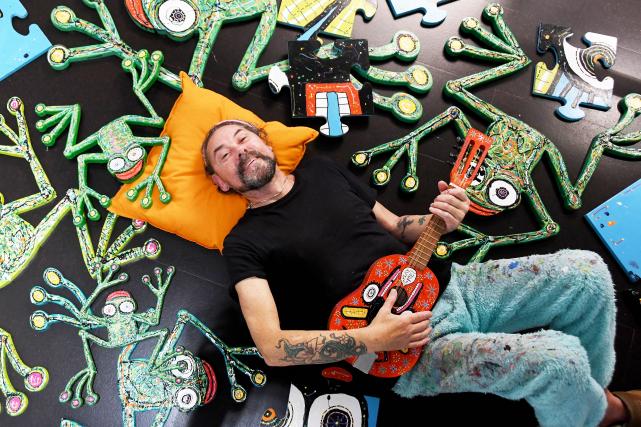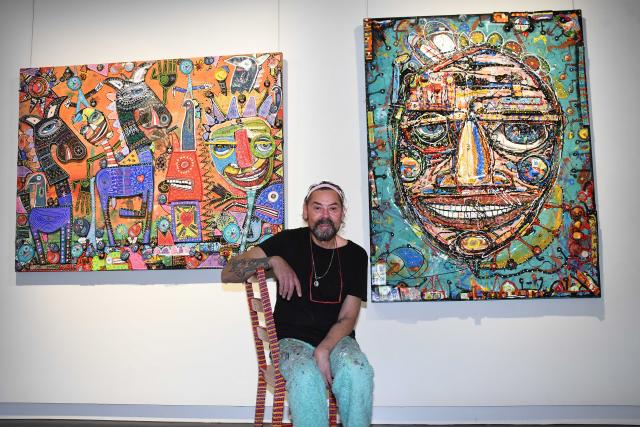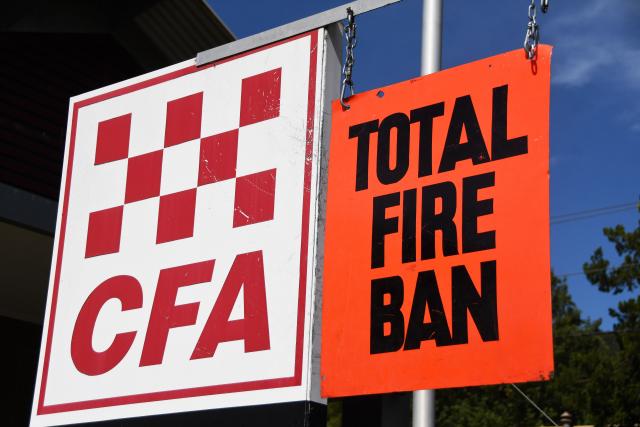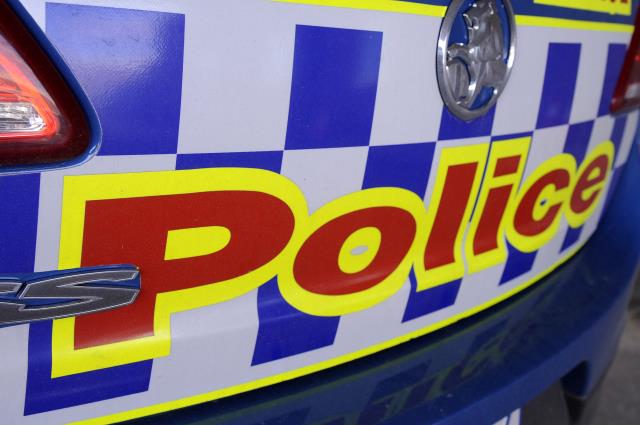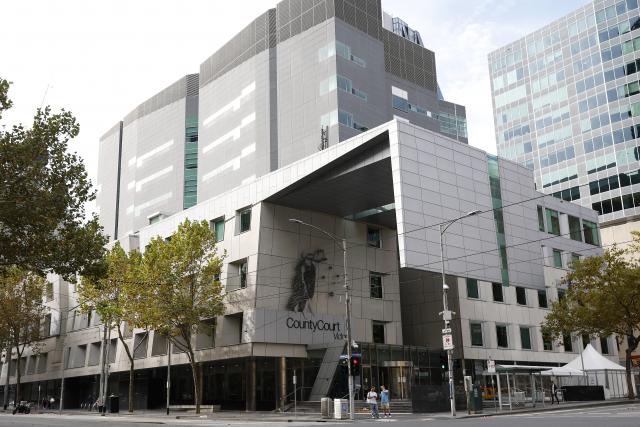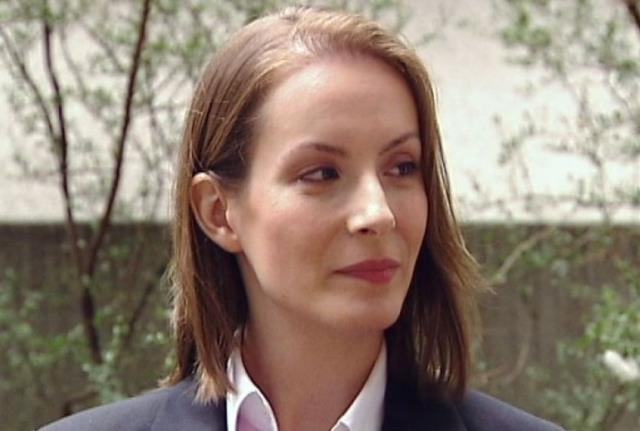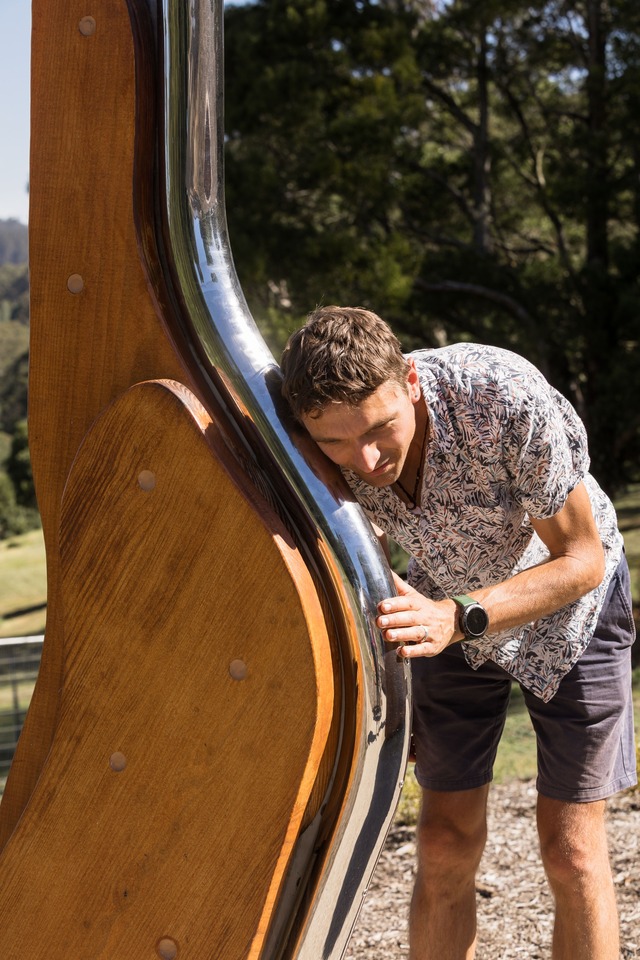It is rare in life to meet somebody who changes your perspective.
Visual artist Anthony Breslin is one of those people.
Despite the obvious pain he is enduring, kindness and self-reflection resonate around him and through his art.
“I’ve probably cost myself time here by doing this show in my condition,” he says candidly, two days before the exhibition’s opening day.
“That may sound dramatic, but it isn’t. I want to hang around, but I’m aware of the fact that I’m not going to be around for a long while.”
Breslin, dressed in a bandana, fuzzy blue pyjama bottoms and paint-splattered slippers, looks every bit the artist you’d expect. His walking cane is always close by, as the toll of his long-term illness makes moving around a Herculean feat.
“When I was in the hospital with leukemia initially, my friends bought in drawing tables for me to use in the isolation and transplant rooms,” he says.
“I started doing all these figures, I had bones, blood and cells in them without even thinking about it.”
Those images Breslin drew after being diagnosed with leukemia in 2014 still hang in the Alfred Hospital today, a long way from Burrinja Cultural Centre, where his first major show in over a decade will be held.
His career has taken many turns, from writing and producing stage plays to working in the film industry and owning a gallery of his own in Carnegie. He’s filled his days creating works for communities, raising thousands of dollars for charity selling art in the Myer windows and meeting lifelong friends along the way.
Creating art is living for Breslin and it’s clear the physical, spiritual and mental anguish caused by his illness won’t stop him from creating.
“There were studios here and when I approached them, they were really happy to have me so they gave me the studio,” Breslin says.
“It was really quiet when I got here because of Covid and they were a bit blown away by me bringing all my assistants and just doing this huge project. They offered me the show and it was a privilege to be offered all the main galleries, which doesn’t happen very often.”
Like his art, Breslin connects with people. In one quiet moment in the art studio, he discusses the intuitive connection between people who have had organ transplants after a chance conversation, seemingly oblivious to the large amount of work he has left to complete before Mélange opens.
Breslin says he is grateful towards what 30 years as a full-time artist has done for him, from making a good income to travelling the world doing what he loves.
“For me to produce a couple of hundred pieces a year to supply all the galleries and then do the shows overseas, I was working around the clock,” he says.
“The more you’re working the faster and the better you get at developing styles.”
Those styles — developed over decades of putting his hands to work — create a psychedelic and surreal variety of work that lives up to the name of the exhibition, taken from old French and meaning ‘a set of diverse elements,’ with pencil drawings he created throughout his travels in the early 1990s vividly contrasting with painted chairs, ukuleles and original works created for Mélange.
At the entry, a video plays of Breslin’s TRYBE: An Opera in Paint, where you catch sight of the man in a very different time in his life. Eclectic performance and powerful movements of artistry create a vivid contrast to his later works, where mortality takes centre stage.
“I realised a long time ago that I don’t make the work. I think everyone has this experience in their own way, whether they acknowledge it or not: it comes through me, not from me,” he says.
“I’ve been so ill for so long, I know about out-of-body experiences myself because I’ve been so close to dying a few times. I’ve had a lot of interesting experiences with letting go of my mortality.”
Within the main gallery, there his recent works — gigantean art pieces combining sculpting and painting — dominate the walls alongside animations of his art, while a stack of intricately painted chairs is positioned centrally within the room.
Next comes his early art, created while travelling to places like Israel and the UK, where he planned to pursue a career in acting, which would form part of his application for formal art education at RMIT University.
The final room in the gallery displays painted ukuleles and frog sculptures, paintings of horses and kangaroos and a giant jigsaw puzzle, adorned with a distinctive style prevalent, although not universal, throughout his work.
“Even if people walk in and go, I don’t like this guy’s work, that doesn’t really affect me because I didn’t really make it in the first place,” he says.
“Even that is an experience for them. It’s telling them something about themselves because you can’t really look at a painting and see the artist, yet you can see a reflection of yourself.
“That’s how life is.”
The opening of Mélange on Saturday 15 October saw friends laud over his achievements, his collaboration with the Coalition for the Protection of Race Horses highlighted and the impact he has had on those around him lamented to a packed house at Burrinja.
A tired Breslin, feeling all the years he has struggled with illness and the toll of creating Mélange, didn’t take the time to shuffle through the gallery alongside his audience. It wasn’t his art after all; it was merely created through him.

